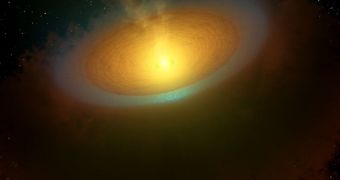Astronomers operating the European Space Agency's (ESA) Herschel Space Observatory announce the discovery of a massive reservoir of water in the protoplanetary disk surrounding the young star TW Hydrae. The reserve holds vast amounts of water, the team explains.
The study revealed that the water vapor which Herschel's sensitive detectors spotted lies on dust grains making up the disk. In our own solar system, such a dust ring was the birth place of all rocky planets, gas giants, comets, meteorites and asteroids.
Early measurements indicate that the amount of water stored in the disk around TW Hydrae represents the equivalent of thousands of oceans here on Earth. This means that there is a great chance that one or more of the planets which will spawn from that disk will contain water, at least in their atmosphere.
The star is located less than 176 light-years away from Earth, which is very close in astronomical terms. Experts say that it first formed around 5 to 10 million years ago, but establishing an exact time when that happened is nearly impossible with current technologies.
Herschel's study represents the first time that water reserves are discovered in the protoplanetary disk of a new star. The telescope was also responsible for finding water on comets that closely resembles that on Earth, in terms of chemical composition and other properties.
In order to see the chemical composition of the disk around TW Hydrae, Herschel used its Heterodyne Instrument for the Far Infrared (HIFI). The tool operates in two sets of wavelengths, from 157 to 212 micrometers and from 240 to 625 micrometers.
The water vapors themselves are produced when ultraviolet radiation from the star and the interstellar medium hits ice that coats individual dust grains in the disk. Any planet that would form from such a ring would have access to large water reserves.
“The detection of water sticking to dust grains throughout the disc would be similar to events in our own Solar System's evolution, where over millions of years, similar dust grains then coalesced to form comets,” Leiden University investigators and study leader Michiel Hogerheijde explains.
“These comets we believe became a contributing source of water for the planets,” the expert adds. Data obtained by Herschel were augmented by observations conducted with the NASA Spitzer Space Telescope, and also by computer models of the protoplanetary disk.
“We already have approved time on Herschel to study more planet-forming regions around three other stars. We believe that will show similar results in terms of the water detections, but as our next observations will be of objects up to three times further in distance away, we'll need many more hours of observation time,” Hogerheijde concludes.

 14 DAY TRIAL //
14 DAY TRIAL //